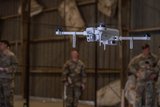SDB II scores direct hit
Raytheon's GBU-53/B Small Diameter Bomb II (SDB II) programme has successfully engaged and hit a moving target during a flight test at the White Sands Missile Range, it was announced on 19 July.
Currently in the engineering and manufacturing development, SDB II is designed to engage moving targets in adverse weather and through battlefield obscurants.
During the July 17 test, the crew of a US Air Force F-15E fighter staging out of Holloman Air Force Base, released the GBU-53/B, which then acquired, tracked and guided to a moving target using its tri-mode seeker, scoring a direct hit, according to a company statement.
'SDB II is the first in the next generation of smart weapons that uses multi- mode seekers and fully networked enabled data links to engage moving targets in bad weather or battlefield obscurants in high threat environments,' said Harry Schulte, vice president of air warfare systems for Raytheon Missile Systems.
'Raytheon is committed to this program's success because SDB II will give the warfighter a mission-flexible weapon capable of defeating threats such as swarming boats, mobile air defense systems or armored targets.'
SDB II was validated by the Department of Defense's Joint Requirements Oversight Council as a weapon that fills a critical capability gap for the military. In addition to its adverse weather, moving-target capability, SDB II can hit targets from stand-off ranges. It has a powerful warhead capable of destroying armored targets, yet keeps collateral damage to a minimum through a small explosive footprint, the company said.
'SDB II's capabilities include the ability for the weapon to be employed in three primary attack modes, each with a subset mode, for a total of six engagement modes. A dual band, two-way weapon data link for in-flight target updates and status reporting allows post-launch control of the weapon by the launching aircraft, a Joint Terminal Attack Controller (JTAC), or a third party,' the statement said.
More from Defence Notes
-
![What will next-gen counter-UAS capabilities for the US look like?]()
What will next-gen counter-UAS capabilities for the US look like?
Future US counter-uncrewed aerial system solutions are likely to require a flexible, multi-layered approach to tackle a broad spectrum of new threats as they emerge.
-
![Elbit Systems awarded $2.3 billion contract as results soar]()
Elbit Systems awarded $2.3 billion contract as results soar
The company’s order backlog as of 30 September totalled $25.2 billion and more than a third of this is scheduled to be fulfilled before the end of 2026.
-
![US military foresees growing use of 3D printing]()
US military foresees growing use of 3D printing
Advanced manufacturing has evolved to meet military requirements and now supports multiple US critical assets, including Arleigh Burke-class destroyers, F-18, F-22, F-35, Bradley, HMMWV and Patriot.
-
![Irish Naval Service expands as the country looks to defence during EU presidency]()
Irish Naval Service expands as the country looks to defence during EU presidency
The Irish Naval Service has struggled to maintain capability, particularly in the face of lucrative private sector offers luring away personnel.
-
![Resilience, adaptiveness and collaboration vital for success in space (Studio)]()
Resilience, adaptiveness and collaboration vital for success in space (Studio)
Speakers at the Defence In Space Conference (DISC) 2025 highlighted the critical and evolving role of space in national security, defence and the global economy.

























